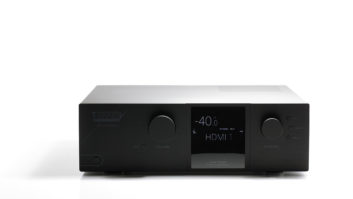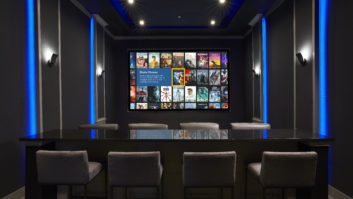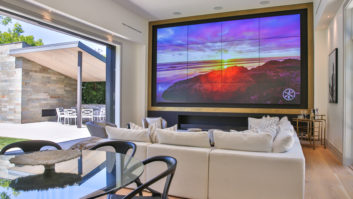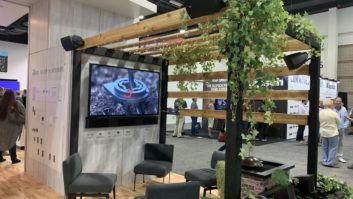The other evening, as I was tip-toeing on top of a chair from our dining room, using a paper clip and the smallest screwdriver I could find trying to pry loose the grille of an older in-ceiling speaker I wanted to replace without totally destroying the grille or falling off the chair, I realized just how far architectural audio speaker technology had come. And I’m not talking about new Rohacell driver technology, and infinitely dense cabinetry bracing or super rare-earth Unobtanium magnets or any of those other technologies designed to make the speaker sound better, I’m talking about all of the design improvements that have made them easier to install!
Sometimes when I am installing something, I ask myself if the person who designed it has ever even bothered to try and install it in the real world. Say, atop a ladder…while trying to balance a level, tape measure, pair of wire strips and a drill. While cradling their product under your arm or balanced precariously amidst a pile of other falderal on the ladder’s fold-out shelf thing. Usually the thought that goes through my mind is something like, “I swear to God! Whoever designed this thing is an idiot! I bet they’ve never even tried to try and put one of these things in!” There’s also a lot of swearing. Feel free to fill in with your favorite words. You know you’ve been there.
But it seems that more and more speaker companies are finally putting their designers up on the ladder, so to speak, and they understand what makes a product easier to install in the field. In turn, this makes your installers more productive, able to get more installs done, and make the company more money. Or, if nothing else, these improved speaker designs decrease the likelihood of them falling off a ladder or dropping something that spirals to the ground only to land blade-down on new hardwood flooring. (I mean, so I’ve been told…)


Paradigm’s new CS v.3 speaker line.
For example, nearly every improvement in Paradigm’s new CS v.3 speaker line launched at this past CEDIA EXPO was made so that the speaker was easier to install. That’s pretty cool. For instance, the speakers have a deeper set-screw that makes it easier to hold the drill bit steady. It’s the kind of thing you might not notice or appreciate until you are fully extended atop a 12-foot ladder. They also re-designed the dog-ear mounting system with an angle to better “bite” into the drywall.
Here are a few other things I’ve noticed with improvements in in-wall/ceiling and outdoor speakers lately that have made installing them a much more pleasant experience.
Cut-Out Templates
Nearly every in-wall/ceiling speaker includes a template to cut out the speaker, but, as Morrissey would say, some templates are better than others. While some include a “bulls eye” in the middle of the template to poke a nail through to center the template, the Sonance Visual Performance speakers I installed the other day have center marks both top/bottom and left/right, making it easy to ensure that I was straight and level and dead on my mark. That’s a simple thing. But it was appreciated.


Sonance’s Visual Performance series.
Magnetic Grilles
Remember when grilles slipped into that micro-thin slot set into the speaker frame/bezel area? It looked like the grille would just slip right in there, and it came tantalizingly close to actually doing it. Except it didn’t. We used to install these speakers that had these really flimsy grilles that you would literally have to fight every millimeter of the way to get set. It could take more than five minutes slowly working the speaker grille into place, pinching and bending and caressing and finessing, the whole time hoping that you weren’t bending the middle out of round so it would be ruined. There were seriously times when we would have to swap out and take turns, letting someone else try their hands at the grill install mojo. And if you ever had to remove one of these grilles, well then you better hope the Force was with you that day, especially if the grilles were outside and likely rusted into place. Contrast that with magnetic grilles on many speakers today that literally snap right into place, no fuss, no muss and never any bending or damage. Not to mention that many of these grilles are micro-perf and just look a lot nicer.
Speaker Hanger Bracket
The Niles Cynema Speaker Soundfield in-wall soundbar is an ingenious design for a variety of reasons, but one of the things I really appreciated about it was this clever hanging bracket they employed. This allows you to hang the speaker modules onto the mounting bracket and frees your hands up to terminate the wiring without trying to do a balancing act while you cradle the speaker in the nook of your arm while one-handing the speaker wire into place. This hanger is such a simple idea that makes installing the product way easier for one man.
Slide-On Mount Bracket
Most surface-mount, outdoor speakers have a bracket that attaches to the wall/eave and then the speaker screws into the bracket with screw knobs on either side. This is serviceable, but when one hand is holding the speaker and the other is locking in the wheel/nut thing, then you’ve got no hands free for things like, say, holding on. On top of a big ladder this can be sketchy. But Sonance introduced a very cool slide-on, locking bracket for its line of Mariner speakers where an arm from the brackets just slides into the speaker and locks into place. Not only can this can be done one-handed, it’s also considerably faster and far less carpal tunnel-ey than dialing those knobs.
An Affront to Geometry: Turning Round Into Square
We’ve all been there…you put in a pair of speakers and then the customer—who totally watched you cutting in the round hole, just standing there, saying nothing—says something like, “Oh…We’re putting round speakers here? I thought they were gonna be square. Yeah. Square…” Now a few companies like Niles and Sonance have introduced adapters that can transform the round into square without any additional cutting, speaker replacing or mess. Suck it, Euclid!
The Posts that Bind
Almost every decent architectural speaker now includes spring-loaded binding posts with generous sized holes to accommodate a variety of large-gauge wire. And if you are new to the install game, you probably figure this is how it has always been. But no. Hells no! It definitely wasn’t always that way. Many speakers used to have those oh-so-cheap spring clips, and these unreliable, tools-of-the-devil would try and betray you at any chance! Like say when you pushed the speaker back up into the ceiling or into the wall, the slightest bit of tension on the wire – like say, a wisp of a draft caused from a squirrel running across the ceiling—would cause the wire to spring free from the hateful clip, making the speaker not work or shorting the amp. Not so, with the mighty spring-loaded post.
Pre-Installation Brackets
Our company used to draw maps for the locations of in-ceiling speakers, and then return later after the drywall was up to cut out the holes. The advantage was the customer wasn’t locked into installing any specific speaker. Or any speaker at all. Plus it made a bigger mess cutting out the drywall after the fact, was more work/time for us, and on more than one occasion, reframing created obstructions that were in our way when we cut in our hole. When we started using pre-install brackets, we found that they were not all created equal. In fact, my installers hated the original brackets that Definitive Technology used so much that we basically didn’t install their in-ceiling speakers. (To our rep’s credit, he responded with an honest, “I know, I know…our brackets suck.”) They were metal and flimsy and the short arms didn’t allow any flexibility to center the speakers up with light cans in a variety of ceiling installs. Fortunately Def Tech went back to the drawing board with its new DI-series of brackets, and now the arms are long on both sides, and feature a mesh that allows you to screw into them in an infinite number of points, making it easy to always get the speaker where you need it to be.
Look, Ma! No Screws!
Nearly every in-ceiling speaker since the dawn of time has included the same four, screw-down, dog-ear mounting mechanism that locks the speaker into place against the sheetrock. Well, Niles flipped the script with its new CM-series, with a new and totally unique tri-mount clip mechanism that made installation incredibly fast, easy and tool free. Niles describes this as “three patent-pending spring tensioned mounting clamps,” but I call it brilliant! Simply pull the tabs down, and slide the speaker into the cut out, and then gently press it up into place. The clips then clamp down, pressure locking the speaker into place. Done and done!
These are some of the tech improvements I’ve noticed in speakers. If you have a favorite, installer-friendly manufacturer or design, tell me about it in the comments.

.
John Sciacca is principal of Custom Theater and Audio in Myrtle Beach, SC.







